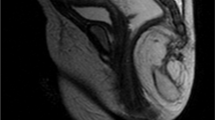Abstract
Purpose
This study aimed to evaluate the incidence and factors associated with long-term functional outcomes of sacrococcygeal teratoma (SCT) after resection in neonates and infants.
Methods
Twenty-nine patients with a minimum of 3 years of follow-up who underwent resection and were histologically diagnosed with SCTs between 1982 and 2017 at our institution were included.
Results
The median age at the time of the study was 10.0 years. Functional disorders occurred after surgery in 6 (20.7%) patients. Anorectal dysfunction, urologic dysfunction, and lower-extremity motor disorders occurred in 6 (20.7%), 4 (13.8%), and 3 (10.3%) patients, respectively. One patient with all three types of functional disorders developed intestinal perforation due to ileus and died of sepsis at 13 years of age. The overall mortality rate after tumor resection was 3.4%. The patients who developed functional disorders presented a low 1-min Apgar score, larger tumors requiring abdominosacral resection, surgical injury to the pelvic organs, and immature or malignant histological findings.
Conclusion
Although the mortality rate was low, the long-term rate of functional disorders after SCT resection was approximately 20%. SCT patients with large tumors, surgical injury to the pelvic organs, and immature or malignant histological findings require thorough follow-up.
Similar content being viewed by others
References
Altman RP, Randolph JG, Lilly JR (1974) Sacrococcygeal teratoma: american academy of pediatrics surgical section survey-1973. J Pediatr Surg 9(3):389–398
Tapper D, Lack EE (1983) Teratomas in infancy and childhood A 54-year experience at the children’s hospital medical center. Ann Surg 198(3):398–410
Huddart SN, Mann JR, Robinson K, Raafat F, Imeson J, Gornall P, Sokal M, Gray E, McKeever P, Oakhill A; Children's Cancer Study Group (2003) Sacrococcygeal teratomas: The UK Children’s Cancer Study Group's experience. I Neonatal Pediatr Surg Int 19(1–2):47–51
Derikx JP, De Backer A, van de Schoot L, Aronson DC, de Langen ZJ, van den Hoonaard TL, Bax NM, van der Staak F, van Heurn LW (2006) Factors associated with recurrence and metastasis in sacrococcygeal teratoma. Br J Surg 93(12):1543–1548
Hambraeus M, Arnbjörnsson E, Börjesson A, Salvesen K, Hagander L (2016) Sacrococcygeal teratoma: a population-based study of incidence and prenatal prognostic factors. J Pediatr Surg 51(3):481–485
Ein SH, Adeyemi SD, Mancer K (1980) Benign sacrococcygeal teratomas in infants and children: a 25 year review. Ann Surg 191(3):382–384
Bond SJ, Harrison MR, Schmidt KG, Silverman NH, Flake AW, Slotnick RN, Anderson RL, Warsof SL, Dyson DC (1990) Death due to high-output cardiac failure in fetal sacrococcygeal teratoma. J Pediatr Surg 25(12):1287–1291
Westerburg B, Feldstein VA, Sandberg PL, Lopoo JB, Harrison MR, Albanese CT (2000) Sonographic prognostic factors in fetuses with sacrococcygeal teratoma. J Pediatr Surg 35(2):322–326
Usui N, Kitano Y, Sago H, Kanamori Y, Yoneda A, Nakamura T, Nosaka S, Saito M, Taguchi T (2012) Outcomes of prenatally diagnosed sacrococcygeal teratomas: the results of a Japanese Nationwide Survey. J Pediatr Surg 47(3):441–447
Malone PS, Spitz L, Kiely EM, Brereton RJ, Duffy PG, Ransley PG (1990) The functional sequelae of sacrococcygeal teratoma. J Pediatr Surg 25(6):679–680
Havránek P, Rubenson A, Güth D, Frenckner B, Olsen L, Kornfält SA, Hansson G (1992) Sacrococcygeal teratoma in Sweden: a 10-year national retrospective study. J Pediatr Surg 27(11):1447–1450
Ozkan KU, Bauer SB, Khoshbin S, Borer JG (2006) Neurogenic bladder dysfunction after sacrococcygeal teratoma resection. J Urol 175(1):292–296
Derikx JP, De Backer A, van de Schoot L, Aronson DC, de Langen ZJ, van den Hoonaard TL, Bax NM, van der Staak F, van Heurn LW (2007) Long-term functional sequelae of sacrococcygeal teratoma: a national Study in The Netherlands. J Pediatr Surg 42(6):1122–1126
Draper H, Chitayat D, Ein SH, Langer JC (2009) Long-term functional results following resection of neonatal sacrococcygeal teratoma. Pediatr Surg Int 25(3):243–246
Le LD, Alam S, Lim FY, Keswani SG, Crombleholme TM (2011) Prenatal and postnatal urologic complications of sacrococcygeal teratomas. J Pediatr Surg 46(6):1186–1190
Lee MY, Won HS, Hyun MK, Lee HY, Shim JY, Lee PR, Kim A (2011) Perinatal outcome of sacrococcygeal teratoma. Prenat Diagn 31(13):1217–1221
Partridge EA, Canning D, Long C, Peranteau WH, Hedrick HL, Adzick NS, Flake AW (2014) Urologic and anorectal complications of sacrococcygeal teratomas: prenatal and postnatal predictors. J Pediatr Surg 49(1):139–143
Hambraeus M, Hagander L, Stenström P, Arnbjörnsson E, Börjesson A (2018) Long-term outcome of sacrococcygeal teratoma: a controlled cohort study of urinary tract and bowel dysfunction and predictors of poor outcome. J Pediatr 198:131–136
De Backer A, Madern GC, Hakvoort-Cammel FG, Haentjens P, Oosterhuis JW, Hazebroek FW (2006) Study of the factors associated with recurrence in children with sacrococcygeal teratoma. J Pediatr Surg 41(1):173–181
Author information
Authors and Affiliations
Corresponding author
Ethics declarations
Conflict of interest
All authors declare that they have no conflict of interest.
Ethical approval
All procedures performed in studies involving human participants were in accordance with the ethical standards of the institutional research committee and with the 1964 Helsinki declaration and its later amendments or comparable ethical standards.
Informed consent
Informed consent was obtained from all individual participants included in the study.
Additional information
Publisher's Note
Springer Nature remains neutral with regard to jurisdictional claims in published maps and institutional affiliations.
Rights and permissions
About this article
Cite this article
Masahata, K., Ichikawa, C., Makino, K. et al. Long-term functional outcome of sacrococcygeal teratoma after resection in neonates and infants: a single-center experience. Pediatr Surg Int 36, 1327–1332 (2020). https://doi.org/10.1007/s00383-020-04752-7
Accepted:
Published:
Issue Date:
DOI: https://doi.org/10.1007/s00383-020-04752-7




